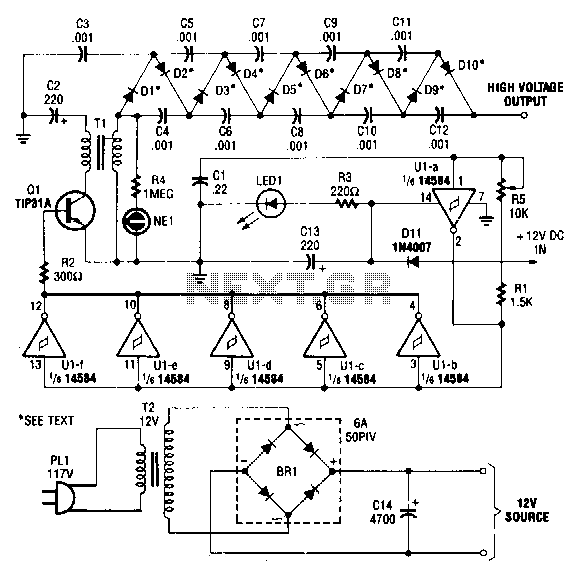
High-voltage-dc-generator

This circuit is powered by a 12-V DC power supply. The input to the circuit is amplified to generate a 10,000-V DC output. The output of the up-converter is subsequently directed into a 10-stage high-voltage multiplier to achieve a final output of 10,000 V DC.
The circuit operates by first utilizing a 12-V DC power supply as its primary energy source. The initial stage involves an up-converter, which is responsible for stepping up the voltage from 12 V to a significantly higher level, necessary for the subsequent high-voltage multiplier stages. The up-converter typically employs a combination of inductive and capacitive components, along with a switching mechanism, to efficiently convert the lower voltage into a higher voltage.
Following the up-converter, the high-voltage multiplier consists of a series of ten stages, each designed to further increase the voltage output. This multiplier configuration generally employs diodes and capacitors arranged in a ladder-like structure. Each stage adds to the voltage by charging and discharging capacitors through the diodes, effectively multiplying the input voltage with each step.
The output of the entire circuit is a stable 10,000 V DC, which can be utilized in various high-voltage applications, such as in electrostatic precipitators, particle accelerators, or other specialized electronic equipment requiring high voltage levels. Proper insulation, safety measures, and component ratings must be considered in the design to ensure safe operation and prevent breakdown or failure of the circuit components.This circuit is fed from a 12-V de power supply. The input to the circuit is then amplified to provide a 10,000-Vdc output. The output of the up-converter is then fed into a 10 stage, high-voltage multiplier to produce an output of 10,000 Vdc. 🔗 External reference
The circuit operates by first utilizing a 12-V DC power supply as its primary energy source. The initial stage involves an up-converter, which is responsible for stepping up the voltage from 12 V to a significantly higher level, necessary for the subsequent high-voltage multiplier stages. The up-converter typically employs a combination of inductive and capacitive components, along with a switching mechanism, to efficiently convert the lower voltage into a higher voltage.
Following the up-converter, the high-voltage multiplier consists of a series of ten stages, each designed to further increase the voltage output. This multiplier configuration generally employs diodes and capacitors arranged in a ladder-like structure. Each stage adds to the voltage by charging and discharging capacitors through the diodes, effectively multiplying the input voltage with each step.
The output of the entire circuit is a stable 10,000 V DC, which can be utilized in various high-voltage applications, such as in electrostatic precipitators, particle accelerators, or other specialized electronic equipment requiring high voltage levels. Proper insulation, safety measures, and component ratings must be considered in the design to ensure safe operation and prevent breakdown or failure of the circuit components.This circuit is fed from a 12-V de power supply. The input to the circuit is then amplified to provide a 10,000-Vdc output. The output of the up-converter is then fed into a 10 stage, high-voltage multiplier to produce an output of 10,000 Vdc. 🔗 External reference